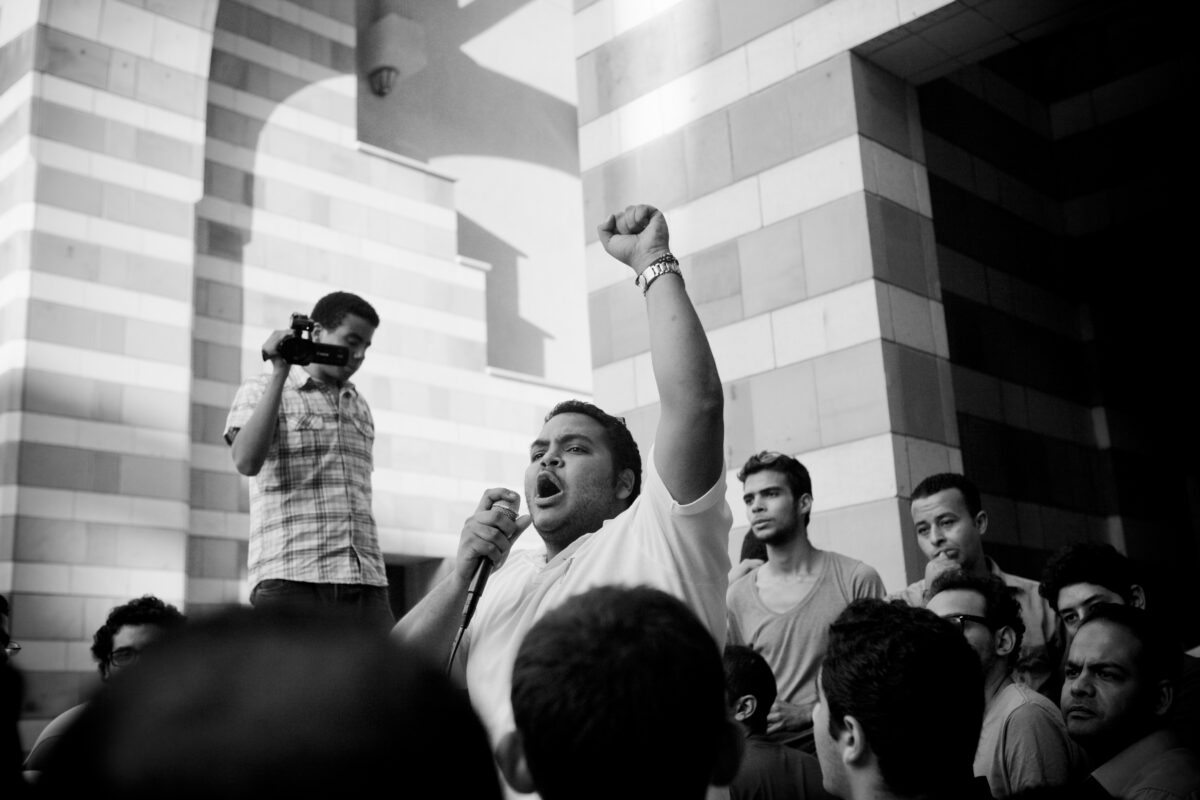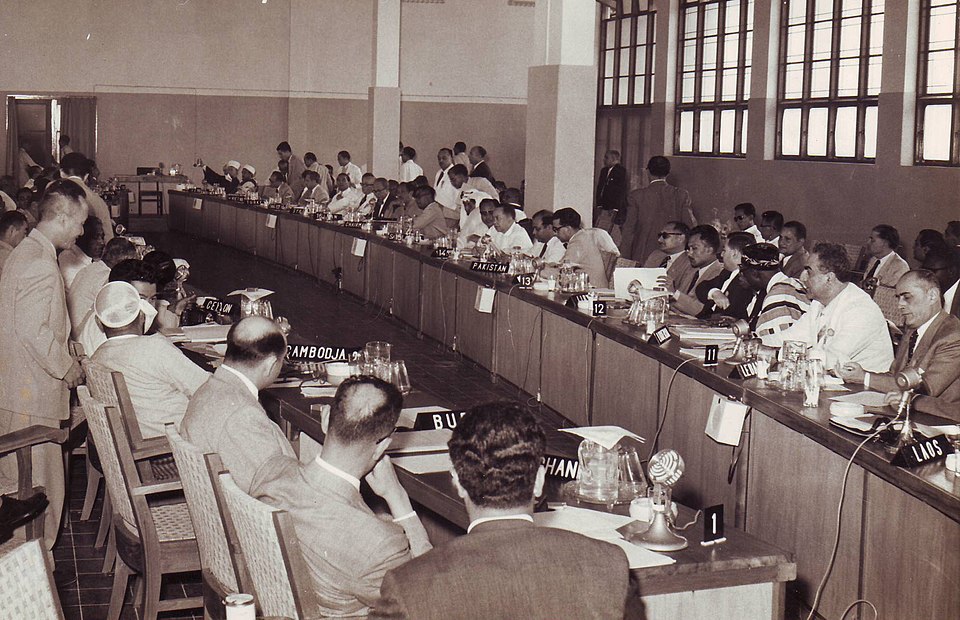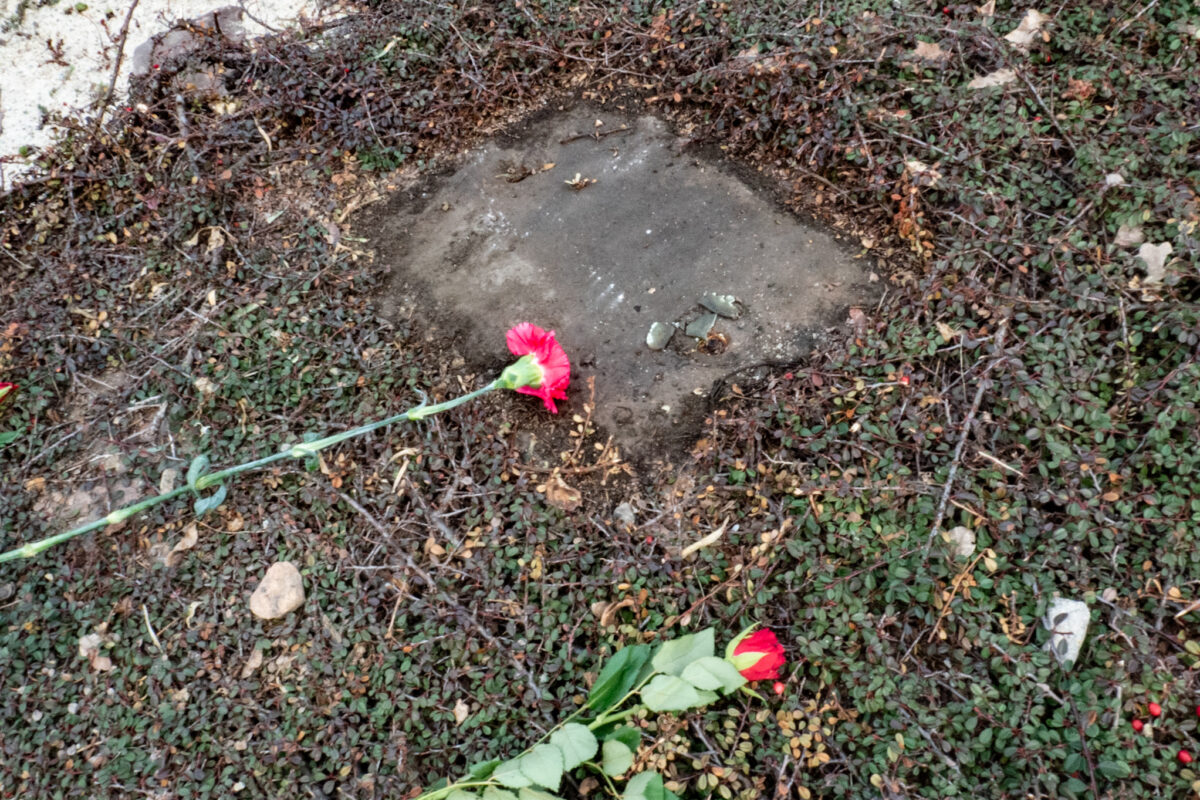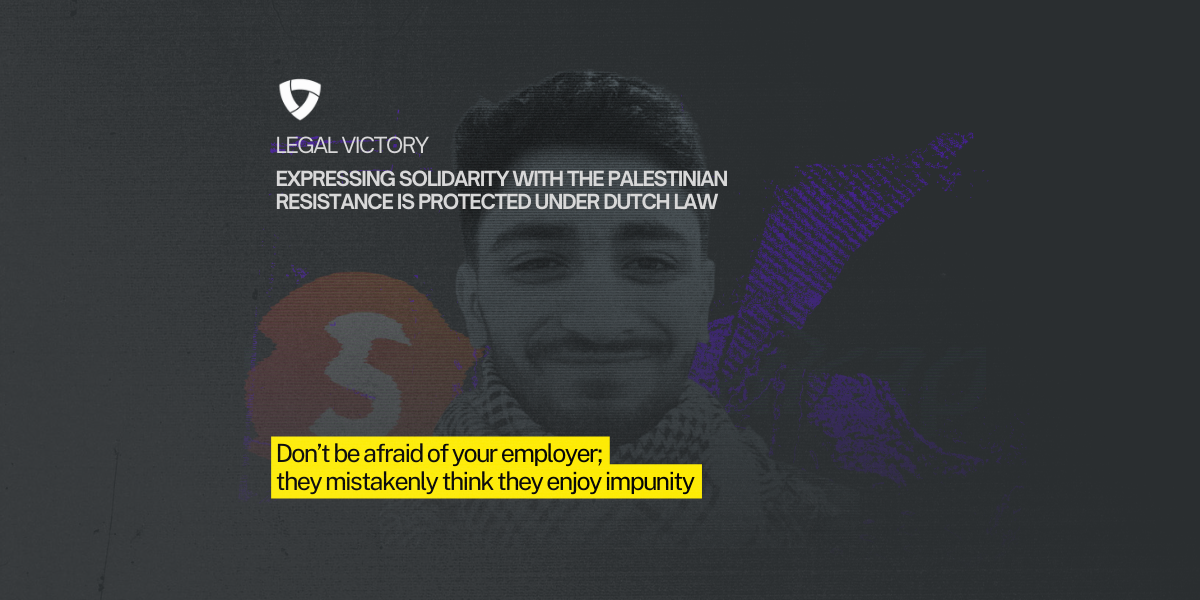Editor’s Note: Phil Butland and Helena Zohdi recently interviewed Hossam el-Hamalawy about the history of the Egyptian Left. You can read Parts 1, 2 and 3 of the Interview here, here and here.
HI Hossam. We finished our last interview with the Kefaya street protests in the early 2000s. Was there similar industrial action?
Not long ago I asked industrial labor leaders, “Where were you when Kefaya was protesting in the streets?” And they said, “We were in front of our TVs, watching those crazy kids burning Mubarak posters in downtown Cairo and in Tahrir Square. And we were looking at one another with disbelief.” But they did start to draw parallels. They thought, “If these kids can take on Mubarak, then we could take on the CEO of a textile mill.”
The strike in Mahalla in December 2006 took place in this context. Mahalla is the biggest textile mill in the Middle East. At the time, it had some 22,000 workers working in a mega-compound.
The women usually worked in the garments sector, with the men in spinning and weaving. The strike started with the women, over bread-and-butter issues like two-month bonuses that were promised but not delivered on by the prime minister.
So the women workers went on strike, touring the factory compound chanting, “Where are the men? Here are the women.” It was a modification of the football chant, “Where are the press? Here are the heroes.” The men then joined the strike, which lasted four days. And despite intimidation by security forces, the workers won.
The victory of the Mahalla workers triggered the “Winter of Labor Discontent,” where nearly all the textile mill workers in Egypt went on strike. Their militancy started spilling over into other industries. Railway workers went on strike, then the cement workers. Strikes were everywhere.
I recall attending a meeting by the EgyptAir Hosts Association in 2007. This was the first time the association had met in ages, but members were encouraged by what was happening in the country. They met because there was anger among air hostesses and hosts about living conditions, salaries, working conditions, and so on. In the middle of the meeting, someone stood up and yelled, “Do we have to act like the textile workers to get our rights in this country?” The Mahalla workers had become a source of inspiration for everyone.
Where do the visuals of these actions fit into the larger picture of the Egyptian strikes?
In 2007, there was not a single factory that I visited while covering industrial actions across the country where I didn’t hear strikers saying, “We saw the Mahalla workers striking, so we decided to strike. We heard that the Mahalla workers are striking. So, we decided to strike. We read in the newspapers that the Mahalla workers are striking. So, we decided to strike.”
The spread of information was essentially an act of education. I was obsessed with how activists could create this sort of domino effect. How can you break your isolation? For me, the answer was the spread of information.
All the time, when activists like myself talked to people about changing Egyptian society, we felt that we were perceived as crazy, and felt isolated. Most people think that it is normal to have rich people and poor people. It’s normal that the police will repress us. Everything that you see around you is being normalized all the time. Marxist philosopher Antonio Gramsci wrote tons about this, when he talked about “common sense.”
But there always is a tiny minority of crazy kids who have ideas about changing the society that they are in. And in Egypt, they were starting to do something about it.
So, if you were in the region of Sharqiya, and you had these ideas, you would feel that you’re not the only crazy one who’s thinking about toppling Mubarak. You would know there are other crazy people in Cairo too who have started to do something. There are people in Alexandria who have started taking action. So why not join them?
This is where visuals were important. Our strategy as Revolutionary Socialists took into consideration that we were still a small group. We had dozens of cadres, with a few hundred members. We had a presence within industrial centers, but it was weak. Our strategy was to engage with the strikers in two ways.
The first thing was to link the strikers together. When we went to the Mahalla textile mill, we told the workers, “By the way, your brothers and sisters in Kafr el-Dawwar are doing the same thing. Why don’t you join forces? If you come to the Center for Socialist Studies, we will hold a public talk about this, and we will invite leaders from the other textile mills where you can meet and start liaising with one another.”
The second strategy was to bombard the public with images from and news of industrial actions. This meant that we talked about the actions all the time, we took photos and videos as much as we could.
At the time, accessing the internet in Egypt was possible but it was still limited. We didn’t yet have 3G or 4G networks. Blogs did exist in 2005 and 2006, on which we could post photos with our statements, and we’d add to posts the web addresses of our blogs and our activist websites. This allowed workers to learn more about us.
At first, some comrades were conservative about this sort of action. They argued that it was virtual reality rather than a real struggle, and that our print newspaper should be our only platform, or at least the most important platform. But these comrades were missing developments that were happening very quickly.
There were cyber cafes in all the neighborhoods in Egypt, including in working-class areas. Kids used to go to these cafes to play games or send emails, or even watch porn. But increasingly, they were also checking out activist blogs.
What was happening to you at the time?
I finished my bachelor’s in economics in 1999, and my master’s in political science in December 2001. I wrote my dissertation on the 1977 uprising and was initially planning to go into academia. But I was blacklisted because of my arrest record. I was banned from taking an academic job.
By sheer coincidence I got into journalism. I worked for local and international newspapers, including the Los Angeles Times. Later I put my media expertise and skills into my organizational work. We started building a media apparatus within the Revolutionary Socialists group. I believe that this strategy of visualizing dissent is what allowed us to punch above our weight.
We were advanced when compared to other groups in terms of using new media, the internet, and visual communications. We also had ideological clarity, unlike the defunct Stalinist groups or other organizations. We understood how these strikes fit into the bigger picture in Egypt.
What happened to Kefaya?
Kefaya fell apart in 2006, as we had been mobilizing to stop Mubarak but he remained in power. Campaign-oriented movements can’t stay the same forever. Statements by Kefaya appeared up until 2011, but honestly, Kefaya was over as a movement by 2006.
When the labor strikes started, the activist community was initially split as how to react. Some argued that we should go to the factories and convince the workers to chant, “Down with Mubarak!” And if they didn’t do this, then they dismissed the factory workers. One famous liberal journalist complained to one of our comrades that the workers were slaughtering themselves just to increase their food allowance by 12 Egyptian pounds.
I belonged to the other part of the activist community. Some of our positions focused on economics, I must admit, but we initially concentrated on engaging with the workers directly, within the limits that they had set for themselves. Because if they achieved their economic demands, they then would gain the courage to start putting forward political demands.
In a way we were right, because when you look at these strikes, at the time Egyptian citizens were living under an emergency law that banned the assembly of more than five people. I grew up and lived all my life under this law. By the way, this is a law that the British had introduced during World War I.
In a country where the assembly of more than five people is illegal, but you’re able to get 22,000 workers to strike, they are in effect breaking the law, and that’s a political decision. People knew they were breaking the law.
Egyptian workers were prepared to strike over bread-and-butter issues even though they knew that outside the factory gates, security forces were waiting to storm in. State security police might raid their homes at night, kidnap them and torture them.
If workers will still strike under these conditions over a 12-pound food allowance, this is a political decision. The striking workers will be necessarily on the receiving end of state repression. In a country where women are second- or even third-class citizens, but are nonetheless spearheading strikes and challenging gender roles, isn’t that politics?
In Egypt, the Copts, or Orthodox Christians, are also second- or third-class citizens and often discriminated against. However, when any sector which has a substantial Coptic presence goes on strike, you find that Muslim workers are more than happy to work with their Orthodox Christian counterparts and elect them to lead the strike, challenging sectarianism. Isn’t that a political decision?
The railways have historically always employed many Copts. And the person who led the railway strikes in 2006 was a Copt. Then there were the tax collectors. Tax collection, because it is a hated job, has historically always been given to minorities like Copts and Jews. There were many Copts among the tax collectors who also went on strike, and many of the leaders and organizers of these strikes were Copts.
Did workers start to generalize?
Yes. Our bet proved to be correct. Because the same Mahalla workers who went on strike in 2006 and 2007 over economic demands decided then that they wanted the establishment of a national minimum wage. On 25 February 2008, 15,000 workers left the Mahalla compound and took to the streets.
They were joined by another 5,000 people, and they were chanting against Mubarak, against his wife Suzanne and his son Gamal, overtly political chants against Mubarak’s family. They threatened that if the government did not submit to their demands of raising the national minimum wage, that they would go on strike on 6 April 2008.
This was preceded by general calls on Facebook and other internet media for a general strike in Egypt. We did not endorse the call for a general strike, as general strikes do not happen this way. Instead, we focused our energies on places where we had roots and presence, such as in Mahalla.
On 6 April, the government went in early and occupied the textile mills. They arrested the strike’s leadership, including our comrades. The factory was occupied by central security forces and the strike was aborted. But from that early hour, locals in town had decided to surround the mill.
Mahalla is like many historic towns in the United States or in Britain, where the whole town is related to a company or some commercial activity. Everyone in Mahalla basically has relatives who work inside the textile plant.
The people surrounding the factory were waiting for the strike to happen. But nothing happened. Then the news trickled out that they had arrested the strike’s leadership. And that’s when the uprising started in earnest.
There are so many conflicting stories about the how the uprising was triggered, and they might all be true. Some people say a police officer hit a woman in El Shone Square, the main square in Mahalla. Others say a child started chanting and he was hit by police. While a general strike did not take place, the town instead erupted in a two-day uprising that was brutally put down by security forces, killing three people.
The news and images of the riots got out to everyone, who saw people from Mahalla stamping their feet on Mubarak posters. And this signaled the beginning of the end of the Mubarak dictatorship. Strikes were now happening everywhere, to the extent that newspapers were full of business experts who complained about the “plague of strikes” that had engulfed Egypt.
We have a proverb in Arabic, which translates into, “If you need something from the dog, tell him that you’re my master.” It’s a symbol for opportunism. This proverb got changed into, “If you need something from the dog, tell him I’m staging a sit-in.” This is the context which led to the Egyptian part of the Arab Spring in 2010 and 2011.
I’m sure our readers can’t wait to hear about this, but we’ve run out of space for this article. We’ll cover the Arab Spring and what followed in the next and final part of this interview.
You can subscribe to Hossam’s blog on contemporary Egyptian politics here.




